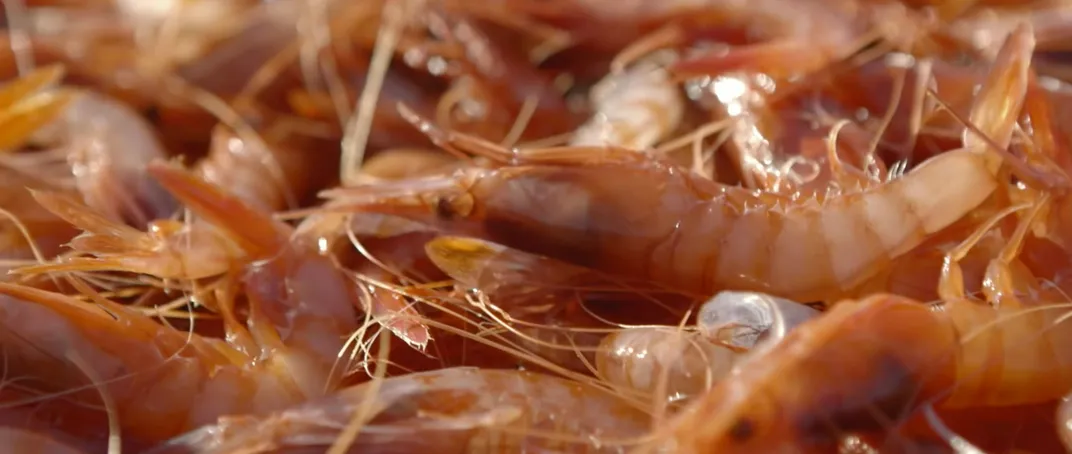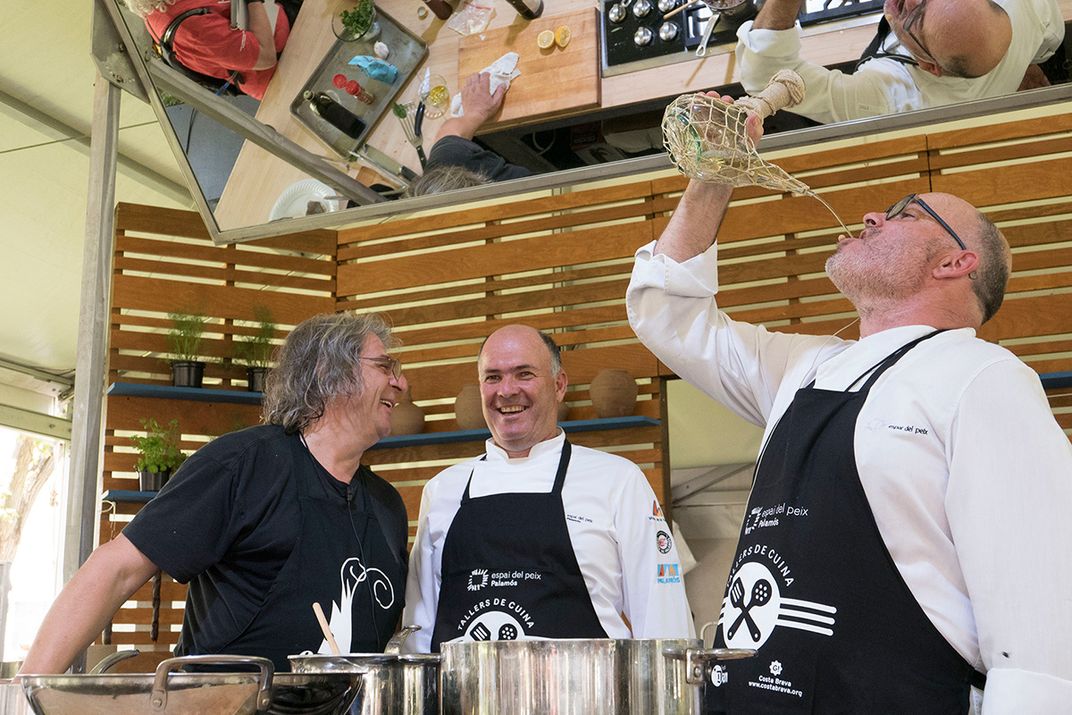How a Fallback to Historic Traditions Might Save Catalonia’s Red Shrimp Fishery
The Boquera brothers, two fishermen from the Costa Brava, are part an innovative management plan that combines science with maritime skills and knowledge
:focal(1171x537:1172x538)/https://tf-cmsv2-smithsonianmag-media.s3.amazonaws.com/filer/8b/a5/8ba5de00-ba9a-4871-b6d6-cc94c65d9779/ramon-felix-boquera.jpg)
At dawn off the port of Palamós in northeastern Spain, the sun emerges from the Mediterranean Sea like a fiery god, holding sway over a ritual that begins as a small fleet of boats pushes east into the new day. Aboard a wooden fishing trawler of about 65 feet, Fèlix Boquera helps ready the trawl net for the day’s work—the pursuit of the gamba roja, red shrimp.
It is work that he has been doing since he was a youngster, along with his twin brother, Ramon. Born into a family of fishermen and trained under the wing of the uncle who raised them from two years old, when their mother died, the brothers are the fourth generation of their family to work the sea off this bold coast, the Costa Brava, of Catalonia.
But while they have pursued this traditional path, they are among a group of local fishermen who are taking innovative and creative steps to maintain their fishery and the culture and history surrounding it. While Fèlix continues to fish within a ground-breaking management plan that supports what he calls “ecological” fishing for the gamba roja, Ramon in 2009 transitioned to the culinary arts focused on promoting local seafood, based at l’Espai del Peix (the Fish Place), a teaching and demonstration kitchen that is part of the Fishing Museum in Palamós.
Both have worked as educators in the Fishing Museum since it opened in 2002, teaching a variety of maritime skills and classes to help maintain and disseminate the heritage that is so unique to this place. Both are sharing those skills and traditions this summer as part of the Smithsonian Folklife Festival, during the brothers’ first visit to the U.S.

While fisherman seek a variety of species off the Costa Brava, the gamba roja occupies a special place, especially in Palamós. Not unlike the blue crab in the Chesapeake Bay, the gamba roja is a regional delicacy that has transcended fishing to become something of a cultural touchstone, and more recently, a draw for tourism. Each summer, the Fira de la Gamba, the Prawn Fair, is held at the town’s famous fish market, Mercat del Peix de Palamós, to raise awareness of the gamba roja as a certified brand, a unique high-quality example of the shrimp that can only be found in Palamós. And from May through mid-July, the Menú de Gamba is offered throughout the region, with eight restaurants in Palamós alone offering menus based on the gamba roja.
This celebration of the shrimp species Aristeus antennatus is well justified. Though the red shrimp makes up only 10 percent of the total landings by weight for the Palamós trawling fleet, it accounts for 50 percent of all income, according to a 2015 paper on management strategies published by scientists from the Institut de Ciències del Mar (ICM, Marine Science Institute) in Barcelona. A deep-sea dweller found between 350 and almost 10,000 feet down, the shrimp is gathered in trawl nets that are lowered to the subterranean mountain slopes and canyons, where they are towed along the seafloor.
Like so many coastal fisheries, the gamba roja was sustainable when fishing was limited to small boats that stuck fairly close to the coast. But as technology increased boats’ size, horsepower, and range, the fleet became more industrialized, and the pressure upon the fishery grew.
The authors of the ICM report analyzed this pressure by examining records on the Catalonian fishing fleet between 1900 and 2013 and then narrowing that to trawling vessels and landings in Palamós and its neighboring community of Blanes. Fishing capacity in Palamós—measured by increases in horsepower (the larger the engine, the greater the vessel’s range and capacity)—grew by 8,782 percent between 1900 and 2013. But the “catch per unit effort” or CPUE, a method of measuring abundance of a particular fish stock, has declined: “In Palamós, the average value of CPUEs for the decade 1963-1972 was 27.9 kg/hp,” the report notes. “In the decade 2003-2012, it had dropped to 4.1 kg/hp.”
“We found that fishing effort directed to this species has increased massively starting from the second half of the last century, accompanied by a marked decline in CPUE,” the report states. “Overfishing of the stock has been evident since 1984.”
Lifelong fishermen like Fèlix and Ramon Boquera didn’t need the data to tell them what they already knew. In 2011, local fishermen in Palamós helped spark an innovative collaboration among scientists, regulators, and the Fishermen’s Association of Palamós to develop a management plan that would create a more sustainable fishery for the prized gamba roja. Scientists from ICM, regional policy makers, and fishermen worked together to gather information on the fishery and fishing methods.
“It is a very novel project. The fact that fishermen and the scientific community are working together in such a united and understanding way is pioneering,” said Rosario Allué Puyuelo, chief of service of marine resources in the Directorate General of Fish and Maritime Affairs.

First approved in 2013 as a five-year trial, and renewed again in June 2018, the Gamba de Palamós Management Plan is the first of its kind in the Mediterranean. Under its structure, only 17 trawlers can fish for the gamba roja, and only during limited daylight hours. Net mesh size and shape have been changed to allow smaller shrimp to escape the trawl, and the fishery is closed entirely for two months when juveniles move into the fishing grounds. And, under the renewed plan, new trawl “doors”—the structures that hold the mouth of the net open—must be the type that fly just above the seabed rather than digging into it, to help prevent destruction of the habitat.
“There are various aspects that I like about fishing for gamba roja,” Fèlix says. “The quality of the product that we fish—Palamós is known for its gamba roja. It also makes me really happy to be able to collaborate to produce a fish that’s more sustainable in terms of the environment, spread ecological awareness, and protect the fishing ground. I like that I am trying to leave a sustainable fish for future generations.”
While the management plan addresses the fishery’s sustainability, the work of organizations like the Fishing Museum and l’Espai del Peix preserves the craft and traditions surrounding this culture.
“L’ Espai del Peix where the Boquera brothers work was created to teach about fishermen’s culture from a double perspective,” says Juan Luis Alegret, an anthropology professor and chair of Maritime Studies at the University of Girona, and advisor to the Fishermen’s Association of Palamós on issues of sustainability and commercialization. “One perspective is to teach the fishing activities that fishermen carry out and the marine species that they capture; the other is to present the long culinary tradition of fishermen in terms of the traditional preparation of certain dishes that have historically been prepared and consumed onboard during their journeys for work (cooking on board). This tradition and culture is very apparent in all of Costa Brava.”
Ramon admits that he misses being on the water every day—“From night to morning, you don’t forget 25 years of fishing,” he says—but through his work at l’Espai del Peix, he stays close to the traditions and fishermen through the culinary arts.
“I try to explain to people who buy and consume fish that there are many species in the Mediterranean that are worth being used in the kitchen [to promote] diversifying the species that fishermen catch,” Ramon says. And at the Nautical and Fishing School of Catalonia, he teaches the skills he learned in the beginning through the family tradition, honed over years of fishing with his brother.
“The most interesting part of being a teacher of knots and nets is being able to pass on all this knowledge to future fishermen and help them in their daily work, teaching them the basic fishing nets to be able to better do their jobs,” Ramon says.
Fèlix also works at the Fishing Museum and at l’Espai del Peix as a maritime expert, a marine knots workshop facilitator, and a tour guide. And every morning, when he heads east into that fiery sun, Fèlix feels the past travel with him.
“The job of a fisherman has always been passed down by oral tradition from father to son,” he says. “This is the way that traditions aren’t lost. By going out to fish every day and applying the knowledge that we learned from our family, we are making sure that those traditions aren’t lost, and at the same time, we become part of the history of the people of the sea.”
The Folklife Festival will conclude after a final run from July 4 through July 8, 2018.
/https://tf-cmsv2-smithsonianmag-media.s3.amazonaws.com/accounts/headshot/WendyClarke1.JPG)


/https://tf-cmsv2-smithsonianmag-media.s3.amazonaws.com/accounts/headshot/WendyClarke1.JPG)
